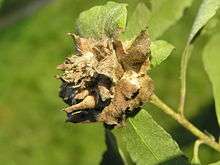Rabdophaga rosaria
| Rabdophaga rosaria | |
|---|---|
 | |
| Scientific classification | |
| Kingdom: | Animalia |
| Phylum: | Arthropoda |
| Class: | Insecta |
| Order: | Diptera |
| Family: | Cecidomyiidae |
| Genus: | Rabdophaga |
| Species: | R. rosaria |
| Binomial name | |
| Rabdophaga rosaria (H. Loew, 1850) | |
| Synonyms | |
| |
Rabdophaga rosaria is a gall midge which forms Camellia galls or terminal rosette gall on willow species.[1][2] It was first described by Hermann Loew in 1850.
Description
Willows are extremely susceptible to gall induction and growth manipulation and Salix is one of the plant genera with the highest known numbers of associated galler species.[3]
R. rosaria is probably a group of closely related, unnamed species, possibly each restricted to one species of willow. Galls should be recorded as R rosaria and the host plant should also be recorded.[4]
The gall consists of from thirty to sixty leaves,[2] shortened and crowded together in rosettes on white willow (S. alba), crack willow (S. fragilis), goat willow (S. caprea) and purple willow (S. purpurea) willows as well as the eared sallow (S. aurita) and grey sallow (S. cinerea).[1] The oviposition of this species results in a chemical interaction that halts the lengthwise growth of infected willow shoots, the leaves however continue to develop and thus the characteristic "rose" forms at the tip of the affected shoot.[3]
Characteristics

R. rosaria is found on willow branches and the gall diameter depends upon the species, being larger on Salix caprea at 8 centimetres (3.1 in) than on Salix alba at 3 cm (1.2 in). The development in the United Kingdom begins in May / June with leaf expansion and reaches maturity in August / September while the leaves are still green. The gall becomes brown and remains on the tree over winter until it is forced off by new growth in spring.[1][2]
Causer, inquiline and associations
Each rosette contains a single pinkish-coloured larva which, unusually, pupates within the gall. Rabdophaga strobilina is closely related and is an inquiline of R. rosaria. One or more larva live under the modified leaves of the rosette and depending on the number of strobilina they can change the shape of the gall from a rosette to a 30–40 mm long cone-shaped artichoke.[4] A common inquiline is another gall midge, Perrisia iteophila and the gall mite Eriophyes marginatus often appears on Camellia galls.[5]
Distribution
R. rosaria is widely distributed throughout the United Kingdom and is locally common.[1] It is abundant in Finland.
Notes
Sources
External links
![]()